YumaMarc
Sr. Member
- Dec 12, 2004
- 493
- 667
- Detector(s) used
- White's MXT
Minelab Quattro
Fisher F2
- Primary Interest:
- Metal Detecting
Even though Honduras is known as the second poorest country in the Western Hemisphere, the rural populace are really rather fortunate. It would be hard to actually starve in the mountains of Honduras. Here are a few photos I took of some things that grow in the hinterlands.
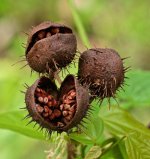 These are Annatto pods, also known as Achiote. The seeds are used in a lot of Latino and Mexican recipes as a mild spice and for color. I took this photo because they look like little monsters from a bad 1950s drive-in movie. I found them in the jungle near Yuscarán, Francisco Morazán.
These are Annatto pods, also known as Achiote. The seeds are used in a lot of Latino and Mexican recipes as a mild spice and for color. I took this photo because they look like little monsters from a bad 1950s drive-in movie. I found them in the jungle near Yuscarán, Francisco Morazán.
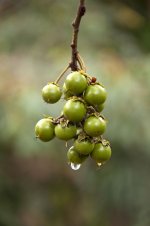 These are called Nances. They resemble cherries, and are about the same size, but are not nearly as acidic or flavorful as cherries. People here eat these things like they're going out of style, but it's obviously an acquired taste which I've never acquired. They're not bad, just rather bland. These are on our tree after a shower.
These are called Nances. They resemble cherries, and are about the same size, but are not nearly as acidic or flavorful as cherries. People here eat these things like they're going out of style, but it's obviously an acquired taste which I've never acquired. They're not bad, just rather bland. These are on our tree after a shower.
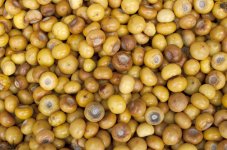 Nances, ripe and ready to cook, or eat, or whatever they do with them. My wife stews them in a sugar syrup. They smell much better than they taste, but she'll argue that point.
Nances, ripe and ready to cook, or eat, or whatever they do with them. My wife stews them in a sugar syrup. They smell much better than they taste, but she'll argue that point.
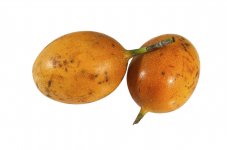 Passion Fruit. They grow on really unobvious vines pretty much everywhere. Sometimes the best way to know you have a Passion Fruit vine is to wait for the fruit to appear. These are kinda like weeds, also.
Passion Fruit. They grow on really unobvious vines pretty much everywhere. Sometimes the best way to know you have a Passion Fruit vine is to wait for the fruit to appear. These are kinda like weeds, also.
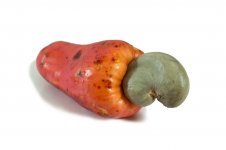 Marañon, or Cashew Apple. These are native to this region, and grow on rather large trees. The fruit is usually made into a jam or jelly, and the seed harvested as a cashew. There's only one cashew per fruit, so you can see why they are so expensive. The gray pod is the cashew hull which exudes a very caustic syrup. The juice from these will damage skin, and especially eyes, so great care is needed to harvest cashews. It takes many many pounds of fruits to have a reasonable amount of cashews.
Marañon, or Cashew Apple. These are native to this region, and grow on rather large trees. The fruit is usually made into a jam or jelly, and the seed harvested as a cashew. There's only one cashew per fruit, so you can see why they are so expensive. The gray pod is the cashew hull which exudes a very caustic syrup. The juice from these will damage skin, and especially eyes, so great care is needed to harvest cashews. It takes many many pounds of fruits to have a reasonable amount of cashews.
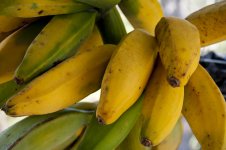 These are a local variety of bananas known as "Butucos". The plants are literally weeds, and once established they are harder than blazes to get rid of. The whole root stock has to be dug up and removed. They have a good flavor, but not quite as fragrant as the common Cavendish banana sold in the US. Birds love them, and when they are ripe on the plant it's time to get your camera out because a zillion tropical birds will be visiting.
These are a local variety of bananas known as "Butucos". The plants are literally weeds, and once established they are harder than blazes to get rid of. The whole root stock has to be dug up and removed. They have a good flavor, but not quite as fragrant as the common Cavendish banana sold in the US. Birds love them, and when they are ripe on the plant it's time to get your camera out because a zillion tropical birds will be visiting.
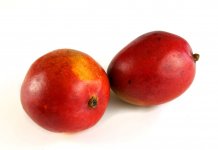 The common Mango, as found in the US. These are seasonal, so when they are ripe you may see big trucks full of these going to market. People here, especially kids, like them green, sliced and salted. In my opinion one of natures finest blessings is green mango jam. If made right, it's like having your toast coated with the best apple pie Grandma ever made. Mango trees can be found along most stream banks. They're almost as common as guavas.
The common Mango, as found in the US. These are seasonal, so when they are ripe you may see big trucks full of these going to market. People here, especially kids, like them green, sliced and salted. In my opinion one of natures finest blessings is green mango jam. If made right, it's like having your toast coated with the best apple pie Grandma ever made. Mango trees can be found along most stream banks. They're almost as common as guavas.
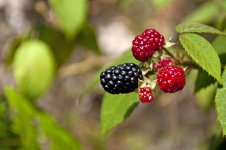 These are Central America's greatest gift to the world. They're called Moras, and are like large blackberries. The remind me of what we called "dewberries" when I grew up in the Ozarks, but grow on a bush rather than a low-lying vine. They have been recognized by horticulturists as having a superior flavor than all other berries of the type, but for some reason they usually refuse to grow in the US. In the mountains of Honduras they are everywhere.
These are Central America's greatest gift to the world. They're called Moras, and are like large blackberries. The remind me of what we called "dewberries" when I grew up in the Ozarks, but grow on a bush rather than a low-lying vine. They have been recognized by horticulturists as having a superior flavor than all other berries of the type, but for some reason they usually refuse to grow in the US. In the mountains of Honduras they are everywhere.
Yes, the rural people of Honduras may be poor financially, but starvation is not an option.
 These are Annatto pods, also known as Achiote. The seeds are used in a lot of Latino and Mexican recipes as a mild spice and for color. I took this photo because they look like little monsters from a bad 1950s drive-in movie. I found them in the jungle near Yuscarán, Francisco Morazán.
These are Annatto pods, also known as Achiote. The seeds are used in a lot of Latino and Mexican recipes as a mild spice and for color. I took this photo because they look like little monsters from a bad 1950s drive-in movie. I found them in the jungle near Yuscarán, Francisco Morazán.  These are called Nances. They resemble cherries, and are about the same size, but are not nearly as acidic or flavorful as cherries. People here eat these things like they're going out of style, but it's obviously an acquired taste which I've never acquired. They're not bad, just rather bland. These are on our tree after a shower.
These are called Nances. They resemble cherries, and are about the same size, but are not nearly as acidic or flavorful as cherries. People here eat these things like they're going out of style, but it's obviously an acquired taste which I've never acquired. They're not bad, just rather bland. These are on our tree after a shower.  Nances, ripe and ready to cook, or eat, or whatever they do with them. My wife stews them in a sugar syrup. They smell much better than they taste, but she'll argue that point.
Nances, ripe and ready to cook, or eat, or whatever they do with them. My wife stews them in a sugar syrup. They smell much better than they taste, but she'll argue that point.  Passion Fruit. They grow on really unobvious vines pretty much everywhere. Sometimes the best way to know you have a Passion Fruit vine is to wait for the fruit to appear. These are kinda like weeds, also.
Passion Fruit. They grow on really unobvious vines pretty much everywhere. Sometimes the best way to know you have a Passion Fruit vine is to wait for the fruit to appear. These are kinda like weeds, also.  Marañon, or Cashew Apple. These are native to this region, and grow on rather large trees. The fruit is usually made into a jam or jelly, and the seed harvested as a cashew. There's only one cashew per fruit, so you can see why they are so expensive. The gray pod is the cashew hull which exudes a very caustic syrup. The juice from these will damage skin, and especially eyes, so great care is needed to harvest cashews. It takes many many pounds of fruits to have a reasonable amount of cashews.
Marañon, or Cashew Apple. These are native to this region, and grow on rather large trees. The fruit is usually made into a jam or jelly, and the seed harvested as a cashew. There's only one cashew per fruit, so you can see why they are so expensive. The gray pod is the cashew hull which exudes a very caustic syrup. The juice from these will damage skin, and especially eyes, so great care is needed to harvest cashews. It takes many many pounds of fruits to have a reasonable amount of cashews. These are a local variety of bananas known as "Butucos". The plants are literally weeds, and once established they are harder than blazes to get rid of. The whole root stock has to be dug up and removed. They have a good flavor, but not quite as fragrant as the common Cavendish banana sold in the US. Birds love them, and when they are ripe on the plant it's time to get your camera out because a zillion tropical birds will be visiting.
These are a local variety of bananas known as "Butucos". The plants are literally weeds, and once established they are harder than blazes to get rid of. The whole root stock has to be dug up and removed. They have a good flavor, but not quite as fragrant as the common Cavendish banana sold in the US. Birds love them, and when they are ripe on the plant it's time to get your camera out because a zillion tropical birds will be visiting.  The common Mango, as found in the US. These are seasonal, so when they are ripe you may see big trucks full of these going to market. People here, especially kids, like them green, sliced and salted. In my opinion one of natures finest blessings is green mango jam. If made right, it's like having your toast coated with the best apple pie Grandma ever made. Mango trees can be found along most stream banks. They're almost as common as guavas.
The common Mango, as found in the US. These are seasonal, so when they are ripe you may see big trucks full of these going to market. People here, especially kids, like them green, sliced and salted. In my opinion one of natures finest blessings is green mango jam. If made right, it's like having your toast coated with the best apple pie Grandma ever made. Mango trees can be found along most stream banks. They're almost as common as guavas. These are Central America's greatest gift to the world. They're called Moras, and are like large blackberries. The remind me of what we called "dewberries" when I grew up in the Ozarks, but grow on a bush rather than a low-lying vine. They have been recognized by horticulturists as having a superior flavor than all other berries of the type, but for some reason they usually refuse to grow in the US. In the mountains of Honduras they are everywhere.
These are Central America's greatest gift to the world. They're called Moras, and are like large blackberries. The remind me of what we called "dewberries" when I grew up in the Ozarks, but grow on a bush rather than a low-lying vine. They have been recognized by horticulturists as having a superior flavor than all other berries of the type, but for some reason they usually refuse to grow in the US. In the mountains of Honduras they are everywhere. Yes, the rural people of Honduras may be poor financially, but starvation is not an option.




